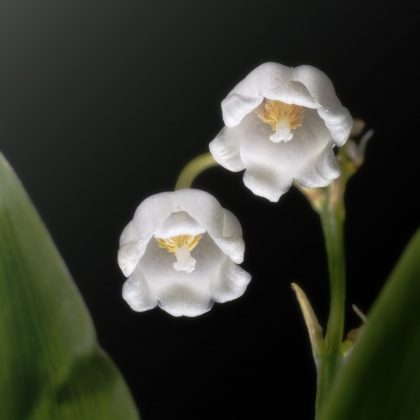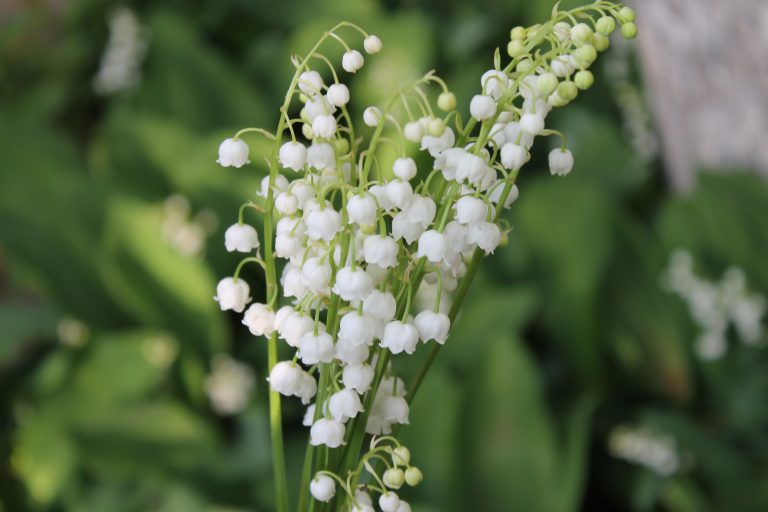Gardening is one of the most rewarding hobbies – you get to see the fruits of your labour develop right before your eyes! Lily of the valley makes for an excellent garden flower as it blooms reliably and adds beauty to its surroundings.
Take a closer look at everything you need to successfully grow gorgeous lily of the valley flowers yourself!
Jump To a Section Below
- What Is Lily Of The Valley?
- How to Grow Lily Of The Valley
- How To Care For Lilies Of The Valley
- What is the Meaning of Lily of The Valley?
- How Poisonous Is Lily Of The Valley?
- Is Lily Of The Valley Invasive?
- What Eats Lily Of The Valley?
- How To Control Lily Of The Valley
- Will Lily Of The Valley Bloom In Its First Year?
- Can You Grow Lily of The Valley In Pots?
- When Can I Dig Up Lily Of The Valley?
What Is Lily Of The Valley?

Lily of the valley is classified as a woodland flowering plant. It carries a sweet scent and boasts pendant, bell-shaped white flowers.
The plant is native to North America, Asia and Europe.
As beautiful as these flowers are, they are also highly poisonous because they have dense cardiac glycosides content. Cardiac glycosides are a class of organic compounds known to increase the output of the heart and decrease its rate of contractions. They can be beneficial for the treatment of congestive heart failure and cardiac arrhythmias but their toxicity in humans and animals alike prevent them from being widely used.
How to Grow Lily Of The Valley
Planting lily of the valley may seem like a daunting task at first, but it can be simplified by considering the following factors.
When to Plant Lily Of The Valley
The best time to plant lilies of the valley is in the later months of autumn.
Where to Plant Lily Of The Valley
Lilies of the valley are best suited to naturalistic gardens dappled in shade. Alternatively, containers can be used if you are looking to control the spread of the plant and ensuring it enjoys adequate moisture.
How to Plant Lily Of The Valley
Be sure to take care when planting lilies of the valley. These plants need to be kept away from children and pets at all times owing to the presence of cardiac glycosides in their chemical makeup.
How To Care For Lilies Of The Valley

Lilies of the valley can tolerate almost any kind of soil but do best when the soil is moist and drains quickly. They can live for quite some time and require very little attention.
If flowering seems to be decreasing over time, the plants can be rejuvenated by lifting and dividing them. There are very few serious pests and diseases that pose a threat to lilies of the valley. In short, what these plants really need to thrive is:
- Partial sun to full shade
- Organically rich soil works best, but they can also perform well in clay soil and high alkaline soil
- One inch of water weekly but more may be required during dry, hot spells
- Cool, moist conditions.
What is the Meaning of Lily of The Valley?

As with many popular flowers, lily of the valley has a lot of meaning attached to it. The scientific name of the plant is Convallaria majalis, which translates to “that which belongs to May”. This makes it the perfect birth flower for the month of May.
These flowers are often viewed as symbols of rebirth and humility and are often used to signify a sense of purity, motherhood, chastity and sweetness.
If you love all things lily you can now grow these gorgeous flowers yourself. As you can see, it’s really quite simple.
How Poisonous Is Lily Of The Valley?
Behind the beautiful flower and pleasant scent of lilies of the valley lies a potential villain. While the plant is safe to be grown in gardens, it’s unsafe to keep it somewhere easily accessible to children and pets. Ingesting the plant could result in a trip to the emergency room and in some extreme but rare cases, death.
Is Lily Of The Valley Invasive?
Lily of the valley can be considered an invasive plant. Once established, the plant is basically unstoppable and will grow rapidly. If you have a tidy garden that is well in order, perhaps look at other plants that are a bit better behaved. However, if you have plenty of space for the plant to spread, it may be perfect for you.
What Eats Lily Of The Valley?
Due to the toxicity of the plant, lily of the valley doesn’t really have any pests or predators. However, crawling gastropods may snack on the leaves. Spider mites are also known to suck sap from the plant’s leaves. This could be an issue for gardeners as it could cause them to turn yellow or to stipple.
How To Control Lily Of The Valley
There are three popular methods used to control lily of the valley plants.
First, and perhaps the easiest one is to install a physical barrier that separates the plant from the rest of your garden.
The next option is to control lily of the valley by digging them out if they seem to be spreading too rapidly. The best time to remove plants is once they have finished blooming for the season, but you can dig them up at any time. However, if you’re wary of destroying a perfectly good plant, repot them and give them to your neighbours or gardening friends – just be sure to remind them that the plant is poisonous and spreads quickly!
Finally, chemicals can be used to control lily of the valley. Be sure to read and follow the label and its directions very carefully. One of the biggest drawbacks about using chemicals is that they are non-selective and could kill any of its surrounding plants, so keep this in mind if this is an option you are exploring.
Will Lily Of The Valley Bloom In Its First Year?
Lily of the valley may well bloom in its first year. The plant typically flowers in early to mid-spring for about three or four weeks.
Can You Grow Lily of The Valley In Pots?
Yes, you can grow lily of the valley in pots. In fact, this makes for a great option for those who want to have the plant around but are hesitant because of the invasive nature of it.
When Can I Dig Up Lily Of The Valley?
Lily of the valley is a hardy and resilient plant, so it can be dug up at any time. However, the easiest time to do so is in the later autumn months when the plant is dormant.

Lily’s love for flowers and plants was nurtured in her grandmother’s vibrant garden. Over the years, this affection blossomed into a full-fledged passion for horticulture.
With formal training in botany and countless hours in her own backyard oasis, Lily has cultivated a deep understanding of plant care and garden design.